Integration of ALOS PALSAR and Landsat Data for Land Cover and Forest Mapping in Northern Tanzania
Abstract
:1. Introduction
2. Study Area
3. Datasets and Methods
3.1. Datasets
3.1.1. Remote Sensing Data
3.1.2. Ground Truth Data
3.2. Methods
3.2.1. Image Pre-Processing
3.2.2. Indices and Textural Parameters Computation
3.2.3. Image Synthesis
3.2.4. Sampling and Land Cover Type Determination
3.2.5. Classification Algorithm and Approach
3.2.6. Classification Accuracy Assessment
4. Results
4.1. Backscattering, Surface Reflectance and Their Derivatives Description
4.2. Spectral Separability Assessments
4.3. Evaluation of Classification Results for Different Data Categories
4.4. Landsat TM and ALOS PALSAR Classification Accuracy
4.5. Integration of TM and ALOS PALSAR
5. Discussion
6. Conclusions
Acknowledgments
Conflicts of Interest
Abbreviations
| ALOS | Advanced Land Observing Satellite |
| ATCOR3 | Atmospheric and Topographic Correction 3 |
| BS | Bare soil |
| con | Contrast |
| Cor | Correlation |
| DEM | Digital Elevation Model |
| DF | Dense Forest |
| dis | Dissimilarity |
| ent | Entropy |
| ETM | Enhanced Thematic Mapper |
| GLCM | Grey Level Co-Occurrence Matrix |
| GPS | Global Positioning System |
| KC | Kappa Coefficient |
| MF | Moderate Forest |
| mea | Mean |
| MIRI | Middle Infrared Index |
| MPSSI | Mean Preservation Speckle Suppression Index |
| NDVI | Normalized Difference Vegetation Index |
| OA | Overall Accuracy |
| PA | Producer’s Accuracy |
| PALSAR | Phased Array type L-band Synthetic Aperture Radar |
| PCA | Principal Component Analysis |
| PolSAR | Polarimetric Synthetic Aperture Radar |
| RFDI | Radar Forest Deforestation Index |
| RS | Remote Sensing |
| SAR | Synthetic Aperture Radar |
| SAVI | Soil adjusted Vegetation Index |
| sec | Second Moment |
| SH | Shrub |
| SLAVI | Soil leaf Area Vegetation Index |
| SRTM | Shuttle Radar Topographic Mission |
| SSI | Speckle Suppression Index |
| SVM | Support Vector Machine |
| TM | Thematic Mapper |
| UA | User’s Accuracy |
| UTM | Universal Transverse Mercator |
| var | Variance |
| VI | Vegetation Index |
| WA | Water |
References
- Liesenberg, V.; Gloaguen, R. Evaluating SAR polarization modes at L-band for forest classification purposes in Eastern Amazon. Int. J. Appl. Earth Obs. Geoinf. 2013, 21, 122–135. [Google Scholar] [CrossRef]
- Attarchi, S.; Gloaguen, R. Classifying complex mountainous forests with L-Band SAR and Landsat data integration: A comparison among different machine learning methods in the hyrcanian forest. Remote Sens. 2014, 6, 3624–3647. [Google Scholar] [CrossRef]
- Li, G.; Lu, D.; Moran, E.; Dutra, L.; Batistella, M. A comparative analysis of ALOS PALSAR L-band and RADARSAT-2 C-band data for land-cover classification in a tropical moist region. ISPRS J. Photogramm. Remote Sens. 2012, 70, 26–38. [Google Scholar] [CrossRef]
- Amarsaikhana, D.; Blotevogelb, H.H.; van Genderenc, J.L.; Ganzoriga, M.; Gantuyaa, R.; Nerguia, B. Fusing high-resolution SAR and optical imagery for improved urban land cover study and classification. Int. J. Image Data Fusion 2010, 1, 83–97. [Google Scholar] [CrossRef]
- Vaglio Laurin, G.; Liesenberg, V.; Chen, Q.; Guerriero, L.; del Frate, F.; Bartolini, A.; Coomes, D.; Wilebore, B.; Lindsell, J.; Valentini, R. Optical and SAR sensor synergies for forest and land cover mapping in a tropical site in West Africa. Int. J. Appl. Earth Obs. Geoinf. 2013, 21, 7–16. [Google Scholar] [CrossRef]
- Wijaya, A.; ReddyMarpu, P.; Gloaguen, R. Discrimination of peatlands in tropical swamp forests using dual-polarimetric SAR and Landsat ETM data. Int. J. Image Data Fusion 2010, 1, 257–270. [Google Scholar] [CrossRef]
- Strömquist, L.; Backéu, I. Integrated landscape analyses of change of miombo woodland in Tanzania and its implication for environment and human livelihood. Geografiska Annaler: Series A. Phys. Geogr. 2009, 91, 31–45. [Google Scholar]
- Liesenberg, V.; Galvão, L.S.; Ponzoni, F.J. Variations in reflectance with seasonality and viewing geometry: Implications for classification of Brazilian savannah physiognomies with MISR/Terra data. Remote Sens. Environ. 2007, 107, 276–286. [Google Scholar] [CrossRef]
- Rosenqvist, A.; Shimada, M.; Ito, N.; Watanabe, M. ALOS/PALSAR: A pathfinder mission for global-scale monitoring of the environment. IEEE Trans. Geosci. Remote Sens. 2007, 45, 3307–3316. [Google Scholar] [CrossRef]
- Lu, D.; Li, G.; Moran, E.; Dutra, L.; Batistella, M. A comparison of multisensor integration methods for land Cover classification in the Brazilian Amazon. GISci. Remote Sens. 2011, 48, 345–370. [Google Scholar] [CrossRef]
- Pohl, C.; Van Genderen, J.L. Multisensor image fusion in remote sensing: Concepts, methods and applications. Int. J. Remote Sens. 1998, 19, 823–854. [Google Scholar] [CrossRef]
- Furtado, L.S.A.; Silva, T.S.F.; Fernandes, P.J.F.; Novo, E.M.L.M. Land cover classification of Lago Grande de Curuai floodplain (Amazon, Brazil) using multi-sensor and image fusion techniques. Octa Amazon. 2015, 45, 195–202. [Google Scholar] [CrossRef]
- Ghulam, A.; Porton, I.; Freeman, K. Detecting subcanopy invasive plant species in tropical rainforest by integrating optical and microwave (InSAR/PolInSAR) remote sensing data, and a decision tree algorithm. ISPRS J. Photogramm. Remote Sens. 2014, 88, 174–192. [Google Scholar] [CrossRef]
- Ratana, P.; Huete, A.R.; Ferreira, L. Analysis of Cerrado physiognomies and conversion in the MODIS seasonal–temporal domain. Earth Interact. 2005, 9, 1–22. [Google Scholar] [CrossRef]
- Rabus, B.; Eineder, M.; Roth, A.; Baler, R. The shuttle radar topography mission—A new class of digital elevation models acquired by spaceborne radar. ISPRS J. Photogramm. Remote Sens. 2003, 57, 241–262. [Google Scholar] [CrossRef]
- Jarvis, A.; Reuter, H.I.; Neson, A.; Guevara, E. Hole-filled SRTM for the globe Version 4. In CGIAR-SXI SRTM 90m Database 2008. Available online: http://srtm.csi.cgiar.org (accessed on 15 July 2011).
- Rousel, J.W.; Haas, R.H.; Schell, J.A.; Deering, D.W. Monitoring vegetation systems in the great plains with ERTS. In Proceedings of the 3rd ERTS Symposium, Washington, DC, USA, 10–14 December 1973.
- Lee, J.S.; Hoppel, K.W.; Mango, S.A.; Miller, A.R. Intensity and phase statistics of multilook polarimetric and interferometric SAR imagery. IEEE Trans. Geosci. Remote Sens. 1994, 32, 1017–1028. [Google Scholar]
- Cantalloube, H.; Nahum, C. How to compute a multi-look sar image? In Proceedings of the Working Group on Calibration and Validation, Toulouse, France, 26–29 October 1999.
- Lee, J.S.; Wen, J.H.; Ainsworth, T.L.; Chen, K.S.; Chen, A.J. Improved sigma filter for speckle filtering of SAR imagery. IEEE Trans. Geosci. Remote Sens. 2009, 47, 202–213. [Google Scholar]
- Shamsoddini, A.; Trinder, J.C. Image texture preservation in speckle noise suppression. In Proceedings of the ISPRS TC VII Symposium—100 Years ISPRS, Vienna, Austria, 5–7 July 2010.
- Dellepiane, S.G.; Angiati, E. Quality assessment of despeckled SAR images. In Proceedings of the 2011 IEEE International Geoscience and Remote Sensing Symposium (IGARSS), Vancouver, BC, Canada, 24–29 July 2011; pp. 3803–3806.
- Shimada, M.; Isoguchi, O.; Tadono, T.; Isono, K. PALSAR radiometric and geometric calibration. IEEE Trans. Geosci. Remote Sens. 2009, 47, 3915–3932. [Google Scholar] [CrossRef]
- Castel, T.; Beaudoin, A.; Stach, N.; Stussi, N.; leToan, T.; Durand, P. Sensitivityofspace-borne SAR data to forest parameters over sloping terrain. Theory and experiment. Int. J. Remote Sens. 2010, 11, 2351–2376. [Google Scholar]
- Ulander, L.M. Radiometric slope correction of synthetic-aperture radar images. IEEE Trans. Geosci. Remote Sens. 1996, 34, 1115–1122. [Google Scholar] [CrossRef]
- Cloude, S.R.; Pottier, E. An entropy based classification scheme for land applications of polarimetric. IEEE Trans. Geosci. Remote Sens. 1997, 35, 68–78. [Google Scholar] [CrossRef]
- Richter, R.; Schläpfer, D. Atmospheric/Topographic Correction for Satellite Imagery (ATCOR-2/3 User Guide, Version 8.2 BETA); German Aerospace Center, Remote Sensing Data Center: Wessling, Germany, 2012. [Google Scholar]
- Richter, R. Correction of atmospheric and topographic effects for high spatial resolution satellite imagery. Int. J. Remote Sens. 1997, 18, 1099–1111. [Google Scholar] [CrossRef]
- Adler-Golden, S.M.; Matthew, M.W.; Bernstein, L.S.; Levine, R.Y.; Berk, A.; Richtsmeier, S.C.; Acharya, P.K.; Anderson, G.P.; Felde, G.; et al. Atmospheric correction for shortwave spectral imagery based on MODTRAN4. Proc. SPIE 1999, 3753, 61–69. [Google Scholar]
- Felde, G.W.; Anderson, G.P.; Cooley, T.W.; Matthew, M.W.; Adler-Golden, S.M.; Berk, A.; Lee, J.S. In Analysis of hyperion data with the FLAASH atmospheric correction algorithm. In Proceedings of the 2003 IEEE International Geoscience and Remote Sensing Symposium, Toulouse, France, 21–25 July 2003; pp. 90–92.
- Wijaya, A.; Gloaguen, R. Fusion of ALOS Palsar and Landsat ETM data for land cover classification and biomass modeling using non-linear methods. In Proceedings of the 2009 IEEE International Geoscience and Remote Sensing Symposium, Cape Town, South Africa, 12–17 July 2009.
- Mitchard, E.T.A.; Saatchi, S.S.; White, L.J.T.; Abernethy, K.A.; Jeffery, K.J.; Lewis, S.L.; Collins, M.; Lefsky, M.A.; Leal, M.E.; Woodhouse, I.H.; Meir, P. Mapping tropical forest biomass with radar and spaceborne LiDAR in Lopé National Park, Gabon: overcoming problems of high biomass and persistent cloud. Biogeosciences 2012, 9, 179–191. [Google Scholar] [CrossRef]
- Haralick, R.M.; Shanmugan, K.; Dinstein, I. Textural features for image classification. IEEE Trans. Syst. Man Cybern. 1973, 3, 610–621. [Google Scholar] [CrossRef]
- Dorigo, W.; Lucieer, A.; Podobnikar, T.; Carni, A. Mapping invasive Fallopia japonica by combined spectral, spatial, and temporal analysis of digital orthophotos. Int. J. Appl. Earth Obs. Geoinf. 2012, 19, 185–195. [Google Scholar] [CrossRef]
- Lu, D.; Batistella, M. Exploring TM image texture and its relationships with biomass estimation in Rondônia, Brazilian Amazon. Acta Amazon. 2005, 35, 249–257. [Google Scholar] [CrossRef]
- Huete, A.R. A soil-adjusted vegetation index (SAVI). Remote Sens. Environ. 1988, 25, 295–309. [Google Scholar] [CrossRef]
- Lymburner, L.; Beggs, P.J.; Jacobson, C.R. Estimation of canopy-average surface-specific leaf area using Landsat TM data. Photogramm. Eng. Remote Sens. 2000, 66, 183–192. [Google Scholar]
- Richards, J.A.; Jia, X. Remote Sening Digital Image Analysis: An Introduction, 3rd ed.; Springer Verlag: Berlin, Germany, 1999. [Google Scholar]
- Karamizadeh, S.; Abdullah, S.M.; Manaf, A.A.; Zamani, M.; Hooman, A. An overview of principal component analysis. J. Signal Inf. Process. 2013, 4, 173–175. [Google Scholar] [CrossRef]
- Lu, D.; Mausel, P.; Brondizio, E.; Moran, E. Relationships between forest stand parameters and Landsat TM spectral responses in the Brazilian Amazon Basin. For. Ecol. Manag. 2004, 198, 149–167. [Google Scholar] [CrossRef]
- Pajares, G.; Cruz, J.M. A wavelet-based image fusion. Pattern Recognit. 2004, 37, 1855–1872. [Google Scholar] [CrossRef]
- Knight, J.F.; Lunetta, R.L.; Ediriwickrema, J.; Khorram, S. Regional scale land-cover characterization using MODIS-NDVI 250 m multi-temporal imagery: A phenology based approach. GISci. Remote Sens. 2006, 43, 1–23. [Google Scholar] [CrossRef]
- Smola, A.J.; Schölkopf, B. A tutorial on support vector regression. Stat. Comput. 2004, 14, 199–222. [Google Scholar] [CrossRef]
- Mountrakis, G.; Im, J.; Ogole, C. Support vector machines in remote sensing: A reiew. ISPRS J. Photogramm. Remote Sens. 2011, 66, 247–259. [Google Scholar] [CrossRef]
- Yang, X. Parameterizing support vector machines for land cover classification. Photogramm. Eng. Remote Sens. 2011, 77, 27–37. [Google Scholar] [CrossRef]
- Congalton, R.G.; Green, K. Assessing the Accuracy of Remotely Sensed Data: Principles and Practices; Lewis Publishers: Boca Raton, FL, USA, 1999. [Google Scholar]
- Schuster, C.; Foerster, M.; Kleinschmit, B. Testing the red edge channel for improving land-use classifications based on high resolution multi-spectral satellite data. Int. J. Remote Sens. 2012, 33, 5583–5599. [Google Scholar] [CrossRef]
- Snedecor, G.W.; Cochran, W.G. Statistical Methods, 8th ed.; Iowa State University Press: Iowa City, IA, USA, 1989. [Google Scholar]
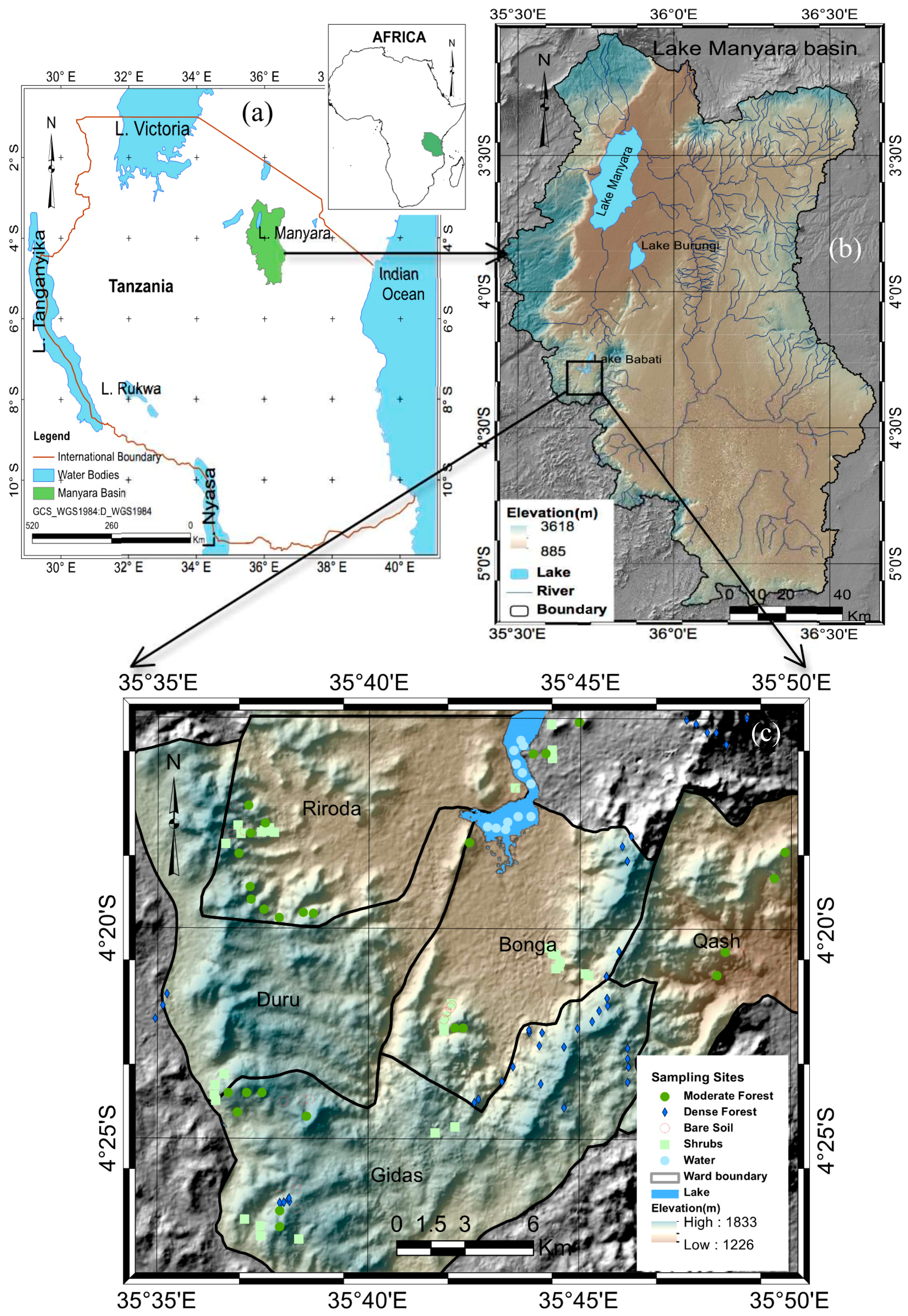


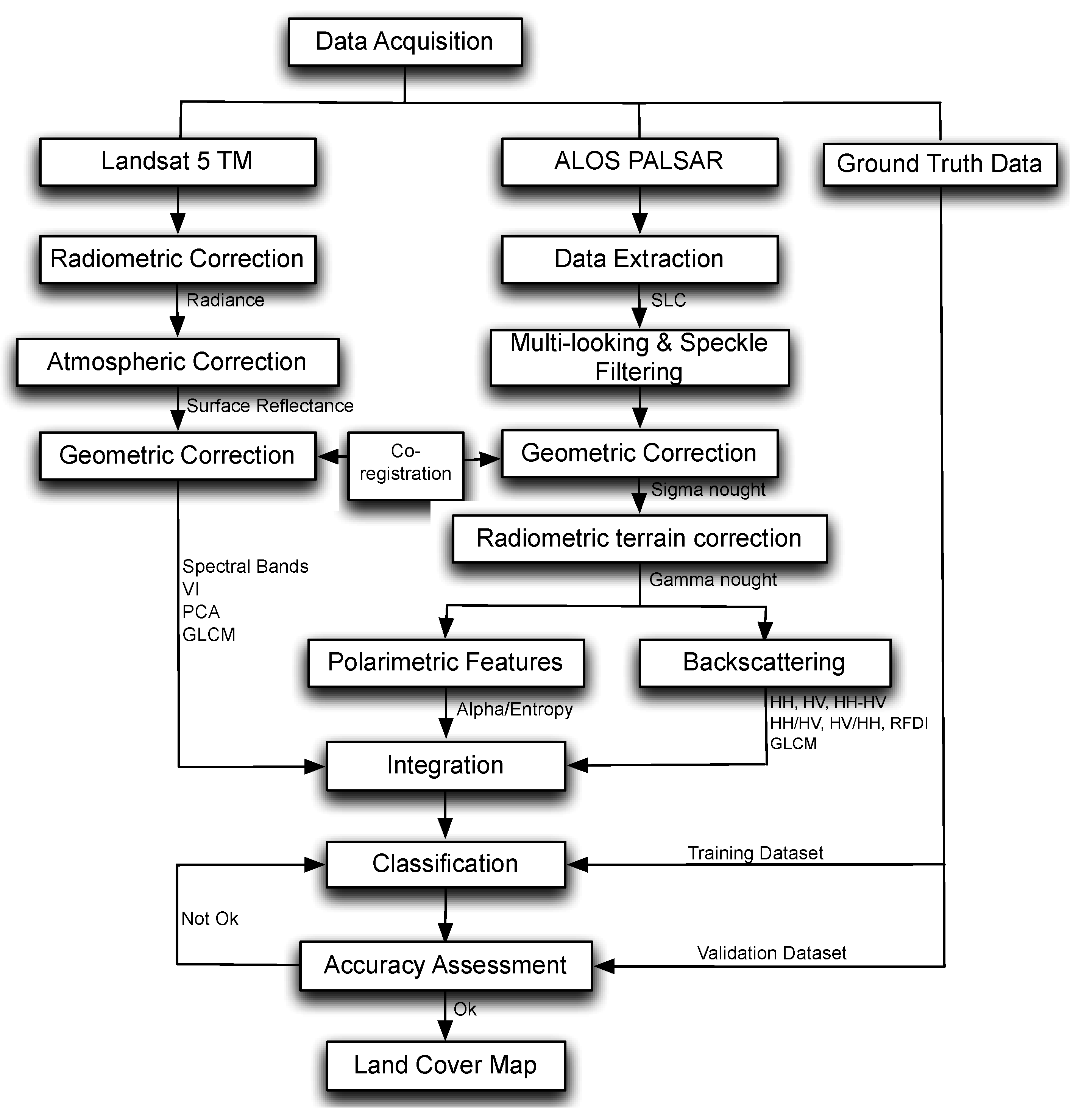
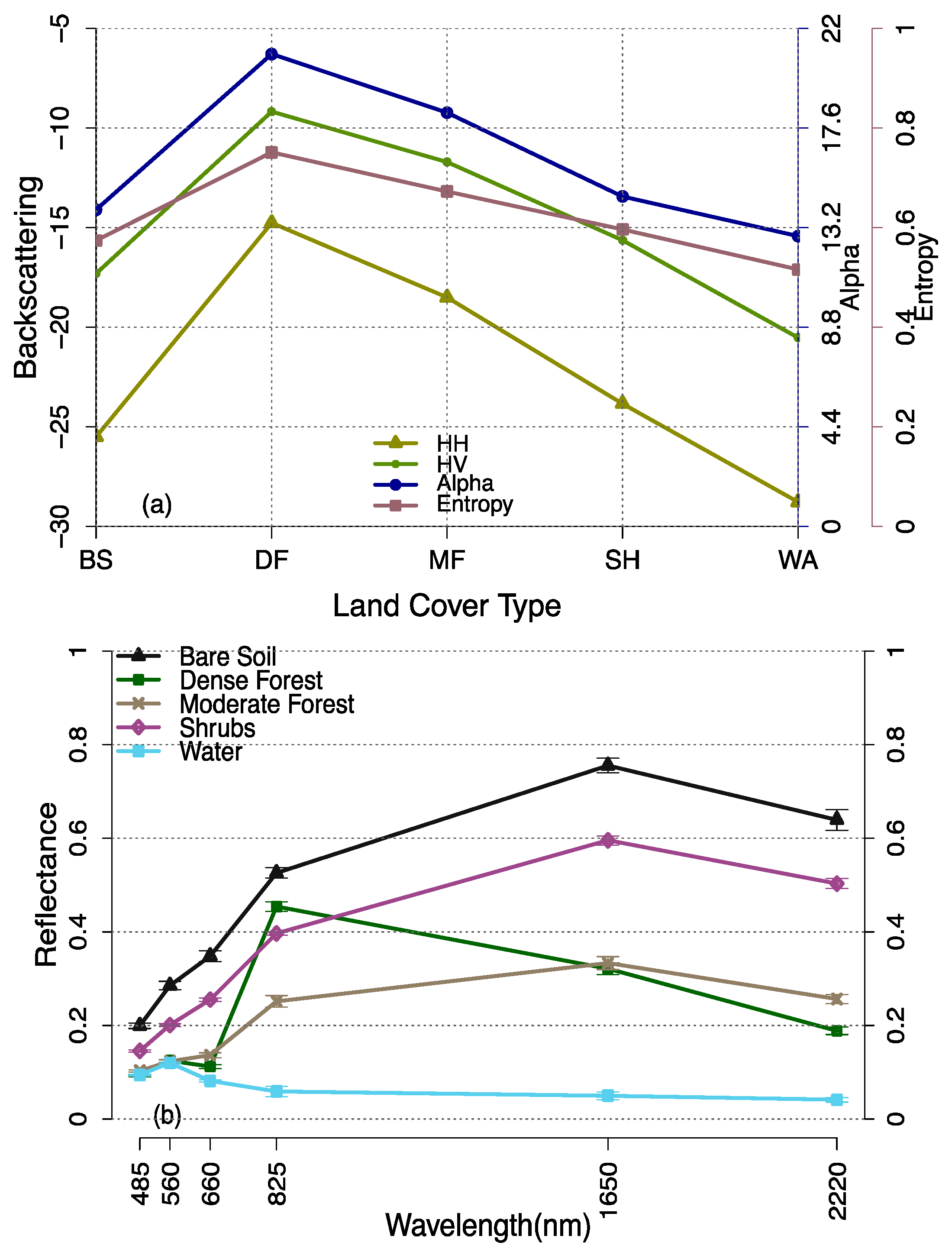
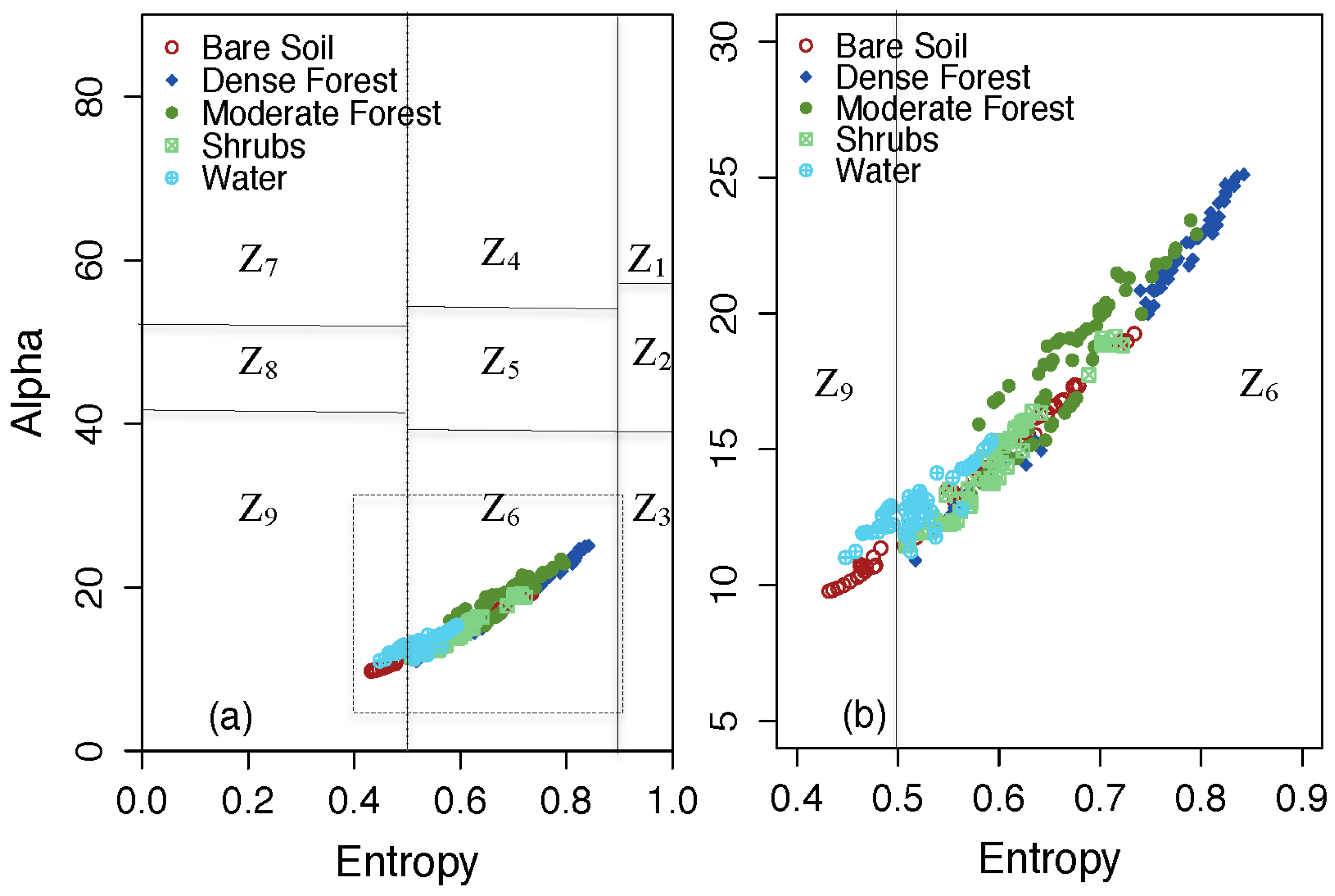
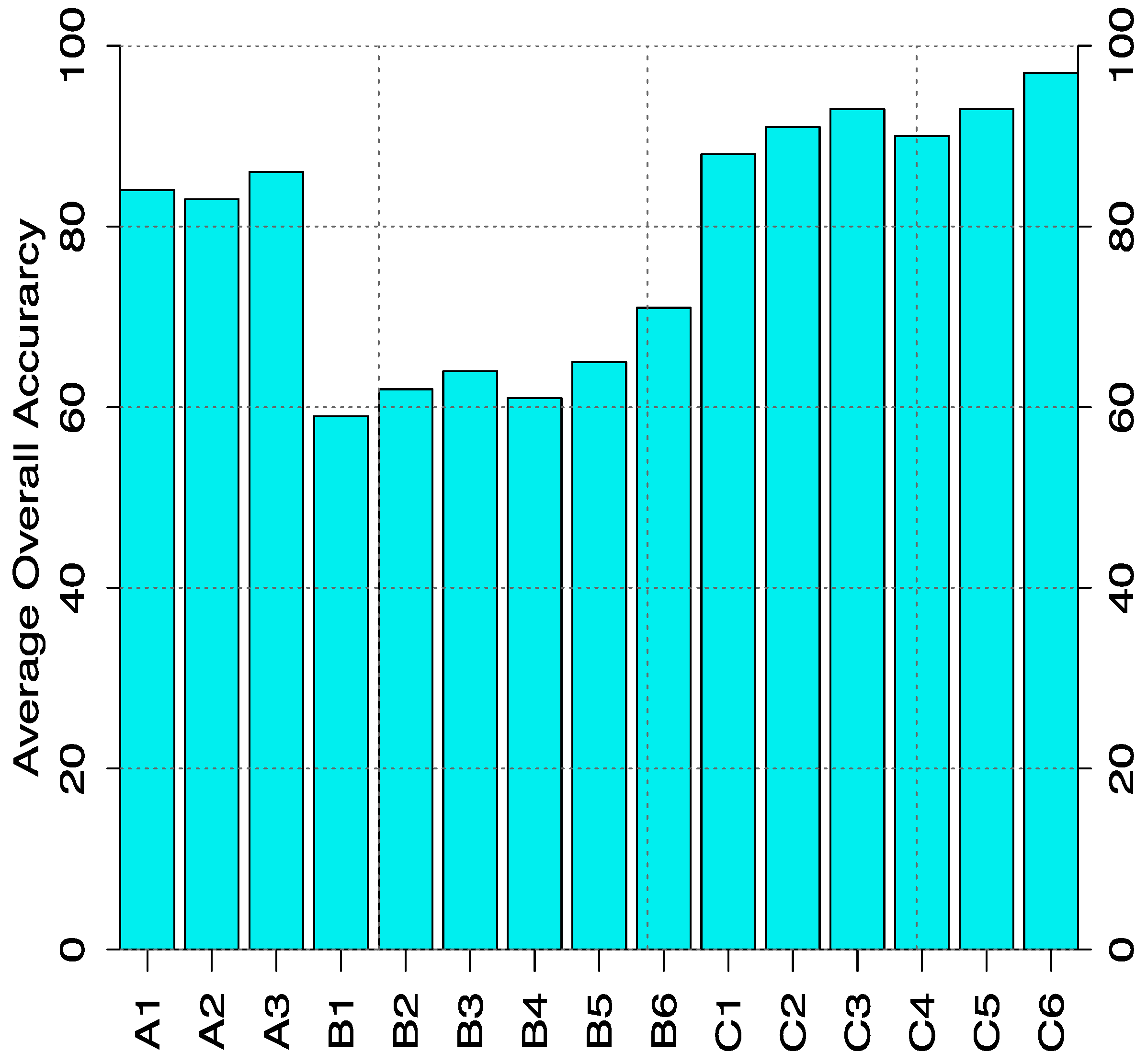

| Land Cover Type | Description |
|---|---|
| Water (WA) | This consist of Lake Babati and wetland areas |
| Shrubs (SH) | This is composed of bushed grasslands, bushed grasslands, which are seasonally inundated, and bush land with scattered cropland and trees |
| Moderate forest (MF) | This is a low density forest, composed of open woodland, closed woodland, wooded grasslands and woodland with scattered cropland |
| Dense forest (DF) | This is a dense forest comprised of forest that reproduce naturally, originating from the original forest cover |
| Bare soil (BS) | This is composed of bare land without grasses, shrubs or forests |
| Satellite/ Sensor | Bands | Acquisition Date |
|---|---|---|
| Landsat 5/TM | 1,2,3,4,5, 7 | 4 November 2009 |
| ALOS/PALSAR | L band | 13 September 2009 |
| Vegetation Indices | Description of Symbols | Reference | |
|---|---|---|---|
| Index Under Study | Formula | ||
| NDVI | (IR − R)/(IR + R) | Normalized Difference Vegetation Index (TM: 660 nm; 830 nm) | [17] |
| SAVI | Soil Adjusted Vegetation Index (TM:660nm; 830 nm) | [36] | |
| SLAVI | Specific Leaf Area Vegetation Index. (TM: 660 nm; 2220 nm) | [37] | |
| RFDI | (HH-HV)/(HH+HV) | Radar Forest Deforestation Index (Measure of different vegetation types cover) | [32] |
| PCA | |||
| PCA1 | 0.054TM1 + 0.130TM2 +0.143TM3 + 0.595TM4 +0.709TM5 + 0.321TM7 | Principal component analysis band 1 | [38,40] |
| PCA2 | −0.079TM1 − 0.121TM2 -0.212TM3 + 0.787TM4 − 0.421TM5 − 0.372TM7 | Principal component analysis band 2 | |
| PCA3 | 0.230TM1 + 0.504TM2 + 0.616TM3 + 0.140TM4 − 0.472TM5 + 0.266TM7 | Principal component analysis band 3 | |
| PCA4 | 0.054TM1 + 0.130TM2 + 0.143TM3 + 0.595TM4 + 0.709TM5 + 0.321TM7 | Principal component analysis band 4 | |
| PCA5 | −0.079TM1 − 0.121TM2 -0.212TM3 + 0.787TM4 − 0.421TM5 − 0.372TM7 | Principal component analysis band 5 | |
| PCA6 | 0.230TM1 + 0.504TM2 + 0.616TM3 + 0.140TM4 − 0.472TM5 + 0.266TM7 | Principal component analysis band 6 | |
| GLCM Textural Measures | |||
| Mean | Measure of textural features; p(i,j) is a normalized grey–tone spatial dependence matrix such that SUM (i,j = 0, N − 1) (P(i,j)) = 1; i and j represent row and column respectively. | ||
| Variance | Measure of textural features; μ is the mean | [34] | |
| Contrast | Measure of textural features, N is the number of distinct grey levels in the quantized image | ||
| Correlation | Measure of textural features; μx, μy, σx and σy are the means and standard deviations of px and py respectively | ||
| Dissimilarity | Measure of textural features | ||
| Entropy | Measure of textural features | ||
| Homogeneity | Measure of textural features | ||
| Angular second moment (ASM) | Measure of textural features | ||
| Category | Datasets | Selected Input Data or Combination | |
|---|---|---|---|
| A | A1 | TM surface reflectance | TM bands (1,2,3,4,5,7) |
| A2 | TM derivatives (VI, PCA and GLCM texture) | PCA1, SLAVI, mea_b1, cor_b3, var_b4, cor_b4, con_b4 | |
| A3 | TM surface reflectance and TM derivatives | TM bands(123457), PCA1, SLAVI, cor_b3, var_b4, cor_b4, con_b4 | |
| B | B1 | PALSAR bands | HH, HV |
| B2 | PALSAR derivatives (RFDI, quotient bands, polarimetric features, and GLCM textures) | RFDI, HH/HV, HV/HH, HH-HV, alpha, entropy, cor_HH, cor_HV, mea_HH, var_HH, sec_HH, sec_HV | |
| B3 | PALSAR bands, RFDI and quotient bands | HH, RFDI, HH/HV, HV/HH, HH-HV | |
| B4 | PALSAR bands, PALSAR GLCM textures | HH, cor_HH, cor_HV, mea_HH, var_HH, se_HH, sec_HV | |
| B5 | PALSAR bands and Polarimetric features | HH, HV, alpha, entropy | |
| B6 | PALSAR bands and their derivatives | HH, HH/HV, HV/HH, alpha, entropy, cor_HH, cor_HV, mea_HH, var_HH, sec_HH, sec_HV | |
| C | C1 | TM surface reflectance, PALSAR bands | TM bands (1,2,3,4,5,7), HH, HV |
| C2 | TM derivatives and PALSAR Bands | PCA1, SLAVI, mea_b1, cor_b3, var_b4, cor_b4, con_b4, HH, HV | |
| C3 | TM derivatives and Polarimetric features | PCA1, SLAVI, mea_b1, cor_b3, var_b4, cor_b4, con_b4, alpha, entropy | |
| C4 | TM derivatives and GLCM textures of PALSAR bands | PCA1, SLAVI, mea_b1, cor_b3, var_b4, cor_b4, con_b4, cor_HH, cor_HV, mea_HH, var_HH, sec_HH, sec_HV | |
| C5 | TM and PALSAR derivatives | SLAVI, cor_b3, var_b4, cor_b4, con_b4, HH/HV, HV/HH, HH-HV, alpha, entropy, cor_HH, cor_HV, mea_HH, var_HH, sec_HH, sec_HV | |
| C6 | TM surface reflectance, PALSAR backscattering and their derivatives | TM bands(1,2,3,4,5,7), HH, HV, SLAVI, cor_b3, var_b4, cor_b4, con_b4, alpha, entropy, cor_HH, cor_HV, mea_HH, var_HH, sec_HH, sec_HV | |
| Class | BS | DF | MF | SH | WA |
|---|---|---|---|---|---|
| HH ( | −25.51 | −14.76 | −18.51 | −23.84 | −28.78 |
| HV ( | −17.31 | −9.18 | −11.70 | −15.63 | −20.52 |
| Alpha () | 13.99 | 20.87 | 18.28 | 14.58 | 12.83 |
| Entropy (H) | 0.57 | 0.75 | 0.67 | 0.60 | 0.52 |
| Class Pair | Category | ||||||||||||||
|---|---|---|---|---|---|---|---|---|---|---|---|---|---|---|---|
| A | B | C | |||||||||||||
| A1 | A2 | A3 | B1 | B2 | B3 | B4 | B5 | B6 | C1 | C2 | C3 | C4 | C5 | C6 | |
| DF-MF | 1.91 | 1.92 | 1.99 | 0.67 | 1.45 | 1.04 | 0.91 | 1.32 | 1.61 | 1.95 | 1.94 | 1.95 | 1.96 | 1.98 | 2.00 |
| DF-SH | 2.00 | 2.00 | 2.00 | 1.95 | 2.00 | 1.99 | 1.97 | 1.99 | 2.00 | 2.00 | 2.00 | 2.00 | 2.00 | 2.00 | 2.00 |
| DF-WA | 2.00 | 2.00 | 2.00 | 1.99 | 2.00 | 2.00 | 2.00 | 2.00 | 2.00 | 2.00 | 2.00 | 2.00 | 2.00 | 2.00 | 2.00 |
| DF-BS | 2.00 | 2.00 | 2.00 | 1.96 | 2.00 | 2.00 | 1.97 | 1.98 | 2.00 | 2.00 | 2.00 | 2.00 | 2.00 | 2.00 | 2.00 |
| MF-SH | 1.96 | 1.99 | 2.00 | 0.78 | 1.80 | 1.74 | 2.00 | 1.67 | 1.91 | 1.98 | 1.99 | 1.99 | 2.00 | 1.99 | 2.00 |
| MF-BS | 1.98 | 1.99 | 2.00 | 1.06 | 1.84 | 1.88 | 1.42 | 1.56 | 1.92 | 1.99 | 1.99 | 2.00 | 2.00 | 2.00 | 2.00 |
| MF-WA | 2.00 | 2.00 | 2.00 | 1.61 | 1.99 | 1.97 | 1.93 | 1.98 | 2.00 | 2.00 | 2.00 | 2.00 | 2.00 | 2.00 | 2.00 |
| SH-BS | 1.95 | 1.83 | 1.99 | 0.34 | 1.57 | 1.46 | 0.79 | 1.31 | 1.76 | 1.98 | 1.94 | 1.96 | 1.96 | 1.99 | 2.00 |
| SH-WA | 2.00 | 2.00 | 2.00 | 1.27 | 2.00 | 1.92 | 1.84 | 1.99 | 2.00 | 2.00 | 2.00 | 2.00 | 2.00 | 2.00 | 2.00 |
| BS-WA | 2.00 | 2.00 | 2.00 | 0.67 | 1.99 | 1.77 | 1.74 | 1.96 | 1.99 | 2.00 | 2.00 | 2.00 | 2.00 | 2.00 | 2.00 |
| Class | Data Category | |||||||||||||||
|---|---|---|---|---|---|---|---|---|---|---|---|---|---|---|---|---|
| A1 | A2 | A3 | B1 | B2 | B3 | B4 | B5 | B6 | C1 | C2 | C3 | C4 | C5 | C6 | ||
| Prod. Acc. | DF | 100 | 96.3 | 96.3 | 48.2 | 55.6 | 3.7 | 25.9 | 66.7 | 48.2 | 100 | 100 | 100 | 96.3 | 96.3 | 96.3 |
| MF | 98.0 | 96.0 | 98.0 | 70.0 | 46.0 | 100 | 40.0 | 54.0 | 46.0 | 98.0 | 98.0 | 98.0 | 98.0 | 98.0 | 100 | |
| SH | 100 | 97.9 | 100 | 56.3 | 70.8 | 43.8 | 70.8 | 62.5 | 77.1 | 100 | 97.9 | 97.9 | 95.8 | 100 | 100 | |
| WA | 92.0 | 92.0 | 96.0 | 72.0 | 80.0 | 76.0 | 76.0 | 72.0 | 80.0 | 96.3 | 92.0 | 96.0 | 96.0 | 96.0 | 96.0 | |
| BS | 96.3 | 96.3 | 96.3 | 44.4 | 44.4 | 44.4 | 48.2 | 55.6 | 48.2 | 88.0 | 96.3 | 96.3 | 96.3 | 96.3 | 96.3 | |
| User. Acc. | DF | 100 | 100 | 100 | 48.2 | 34.9 | 100 | 18.4 | 42.9 | 31.7 | 100 | 100 | 100 | 100 | 100 | 100 |
| MF | 96.1 | 94.1 | 96.1 | 57.4 | 46.9 | 52.1 | 35.1 | 52.9 | 44.2 | 94.2 | 96.1 | 98.0 | 96.0 | 96.1 | 96.2 | |
| SH | 96.0 | 94.0 | 96.0 | 65.9 | 81.0 | 84.0 | 82.9 | 76.9 | 80.4 | 96.0 | 95.9 | 95.9 | 95.8 | 96.0 | 98.0 | |
| WA | 100 | 100 | 100 | 94.7 | 100 | 90.5 | 100 | 100 | 100 | 100 | 100 | 100 | 100 | 100 | 100 | |
| BS | 100 | 96.3 | 100 | 41.4 | 52.2 | 35.3 | 59.1 | 55.6 | 72.2 | 100 | 96.3 | 96.3 | 92.8 | 100 | 100 | |
| F1 Score | DF | 1.00 | 0.98 | 0.98 | 0.48 | 0.43 | 0.07 | 0.22 | 0.52 | 0.38 | 1.00 | 1.00 | 1.00 | 0.98 | 0.98 | 0.98 |
| MF | 0.97 | 0.95 | 0.97 | 0.63 | 0.46 | 0.68 | 0.37 | 0.53 | 0.45 | 0.96 | 0.97 | 0.98 | 0.97 | 0.97 | 0.98 | |
| SH | 0.98 | 0.96 | 0.98 | 0.61 | 0.76 | 0.58 | 0.76 | 0.69 | 0.79 | 0.98 | 0.97 | 0.97 | 0.96 | 0.98 | 0.99 | |
| WA | 0.96 | 0.96 | 0.98 | 0.82 | 0.89 | 0.83 | 0.86 | 0.84 | 0.89 | 0.98 | 0.96 | 0.98 | 0.98 | 0.98 | 0.98 | |
| BS | 0.98 | 0.96 | 0.98 | 0.43 | 0.48 | 0.39 | 0.53 | 0.56 | 0.58 | 0.94 | 0.96 | 0.96 | 0.95 | 0.98 | 0.98 | |
© 2016 by the author; licensee MDPI, Basel, Switzerland. This article is an open access article distributed under the terms and conditions of the Creative Commons Attribution (CC-BY) license (http://creativecommons.org/licenses/by/4.0/).
Share and Cite
Deus, D. Integration of ALOS PALSAR and Landsat Data for Land Cover and Forest Mapping in Northern Tanzania. Land 2016, 5, 43. https://doi.org/10.3390/land5040043
Deus D. Integration of ALOS PALSAR and Landsat Data for Land Cover and Forest Mapping in Northern Tanzania. Land. 2016; 5(4):43. https://doi.org/10.3390/land5040043
Chicago/Turabian StyleDeus, Dorothea. 2016. "Integration of ALOS PALSAR and Landsat Data for Land Cover and Forest Mapping in Northern Tanzania" Land 5, no. 4: 43. https://doi.org/10.3390/land5040043







